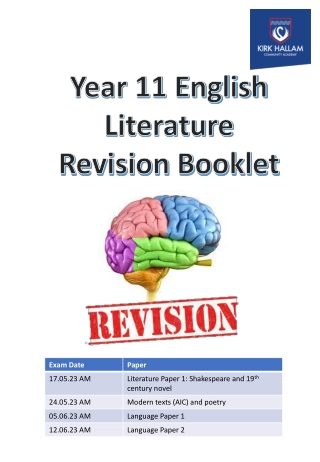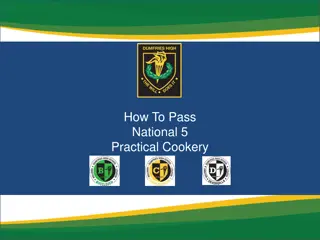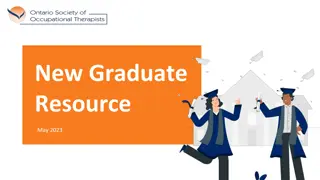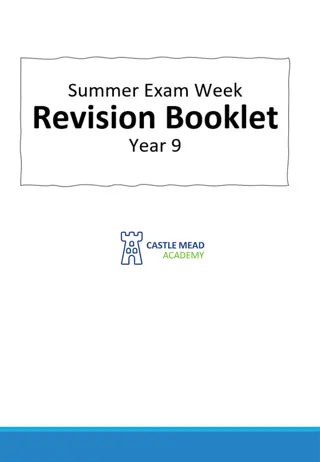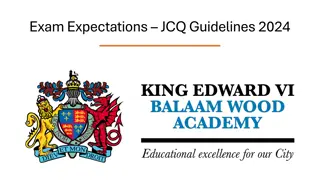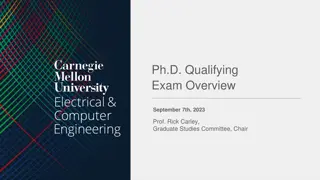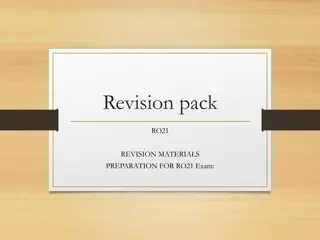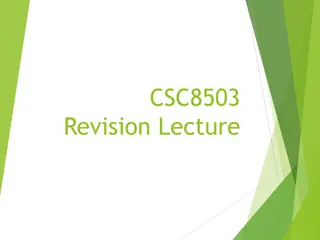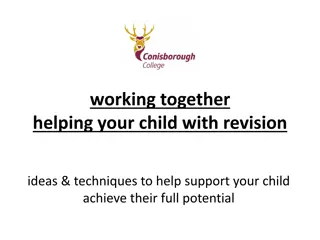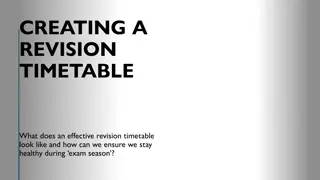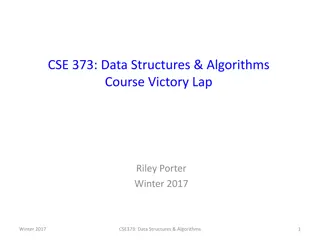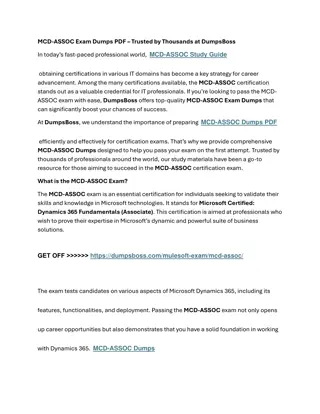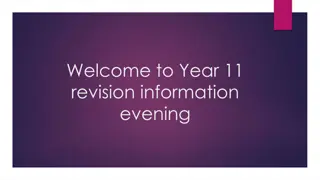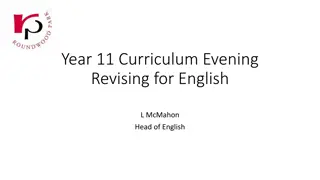English for IT Final Exam Revision
This revision guide covers Learning Outcomes 5, 6, and 7 for the English for IT final exam. It includes vocabulary topics related to jobs in IT, the Internet, the web, cyber collectives, video conferencing, chat etiquette, program design, computer languages, and Java. The guide also provides assignment types and sample tasks to help with exam preparation. Utilize the provided learning materials, PowerPoint slides, and key concepts to enhance your understanding and ace the exam.
Download Presentation

Please find below an Image/Link to download the presentation.
The content on the website is provided AS IS for your information and personal use only. It may not be sold, licensed, or shared on other websites without obtaining consent from the author.If you encounter any issues during the download, it is possible that the publisher has removed the file from their server.
You are allowed to download the files provided on this website for personal or commercial use, subject to the condition that they are used lawfully. All files are the property of their respective owners.
The content on the website is provided AS IS for your information and personal use only. It may not be sold, licensed, or shared on other websites without obtaining consent from the author.
E N D
Presentation Transcript
ENGLISH FOR IT Revision for the Final Exam LO 5,6,7
LO 1 2 3 5 6 7 Total 15 15 5 15 15 10 75 Points points 200 min 30 min 35 min 30 min 30 min 35 min 40 min Time
LEARNING OUTCOME 5 - VOCABULARY TOPICS: JOBS IN IT THE INTERNET AND THE WEB THE COLLECTIVES OF CYBERSPACE VIDEO CONFERENCING, CHAT AND NETIQUETTE PROGRAM DESIGN, COMPUTER LANGUAGES AND JAVA INITIALISMS COVERED AFTER THE MIDTERM
Learning material PPTS available on IE Remacha, Infotech Units 16,17,18, 24, 25 Hill, English for Information Technology 2. Pearson Education ELS - Units 1,8,6 Marks, Vocabulary Book Section 3 the Internet
Assignment types 1. Match up the following words from the box with their definitions below. 2. Write the meaning of these IT initialisms. Please note that the spelling must be correct to earn points. 3. Use the words or word combinations in the box to complete the sentences below.
Sample Task 1 1. ________________ - a system in which each server hosts only one client s websites on it BUG DEBUG 2. ________________ - a way to fit audio or video into a smaller space and use less bandwidth ENCRYPTION COMPRESSION 3. _______________- find problems in a computer program and correct them DEDICATED HOSTING SHARED HOSTING 4. _______________ - a data security system which is used over the Internet and other open networks VIDEO CONFERENCING
Key 1. DEDICATED HOSTING 2. COMPRESSION 3. DEBUG 4. ENCRYPTION
Sample Task 2 1. WI FI 2. DTP 3. BCC 4. URL 5. FTP 6. B2B 7. EDI 8. XML
Key 1. WI FI wireless fidelity 2. DTP desktop publishing 3. BCC blind carbon copy 4. URL uniform resource locator 5. FTP file transfer protocol 6. B2B business to business 7. EDI electronic data interchange 8. XML extensible mark-up language
Sample Task 3 bid, down, encrypted, online, outbid, padlock, secure server, system 1. Sites that ask for your credit card number or other personal information should use a _________________ ______________, so the data you send is _________________. 2. A: "Have you ever bought anything on an auction site like eBay?" B: "No. Once I made a _________________ on something, but I was _________________ a few seconds before the auction closed." 3. The _________________ symbol means that a web-page is secure. 4. I couldn't book my flight _________________ because the airline s ________________ was _________________.
Key 1 secure server / encrypted, 2 bid / outbid, 3 padlock, 4 online / system / down
LEARNING OUTCOME 6 - GRAMMAR Present Simple Present Continuous Past Simple Past Continuous Present Perfect Simple Present Perfect Continuous Past Perfect Simple Past Perfect Continuous Reported Speech
PRESENT SIMPLE Used to express habits, general truths, repeated actions or unchanging situations, emotions and wishes Key words: always, usually, often, sometimes, seldom, rarely . I always eat my breakfast in the morning. The Earth revolves around the Sun. She enjoys playing the piano.
PRESENT CONTINUOUS Used for actions that are happening right now or actions that are going on during this period of time or a trend Key words: now, currently, at this moment Currently, I am eating my breakfast. Currently the school is working on implementing the new healthy menu. (is in the process of doing this) Right now people are buying faux fur like crazy! (during this period faux fur is trendy) (!! Be careful when forming the ing form of the verbs, if a verb ends in the letter e, we drop the e right before the ing suffix)
PAST SIMPLE Used for completed past actions that happened at a specific time in the past and to talk about past events that followed one after another in the past. Key words: last year, yesterday, three weeks ago (any time we have a specific time in the past) .. I came to this town three years ago. I called her yesterday. She stood up, took her bag and walked out of the room.
PAST CONTINUOUS used to show that an ongoing past action was happening at a specific moment of interruption, or that two ongoing actions were happening at the same time. We were eating breakfast when she called. While my friends were playing video games, we were cleaning the living room.
PRESENT PERFECT Used for actions that started in the past but still have some effect on the present, actions performed during a period that has not yet finished, actions that were completed in the very recent past, expressed by 'just', actions that denote experience Key words: since, for, already, yet, before, ever, never, still not, so far, just, up to now, recently, until now . We have lived here since 1989. (and we still do) (LIVE and WORK can be used either in the Present Perfect Simple or the Continuous Form interchangeably) I have known about her secret for five months now (and I still do) (we do not use the continuous form with the verb know) I have talked to three people this morning (and it s still morning) vs I talked to three people in the morning (morning is over) Have you ever read Hamlet? (i.e. do you have the experience of reading Hamlet) BUT Did you read Hamlet last year? (specific time) (be careful when putting has or have has ONLY goes with third person singular) also DO NOT mix Present Perfect with Past Perfect (I have learned vs. I had learned not the same thing)
PRESENT PERFECT CONTINUOUS The present perfect simple (I ve read) gives the idea of completion while the present perfect continuous (I ve been reading) suggests that something is unfinished. The present perfect continuous (has been writing) talks about how long something has been happening. The present perfect simple (has written) talks about how much/how many have been completed. Key words: for xy years/days/ages I have been writing this email for ages (but I am still not done). I have written this email recently- Present Perfect Simple! (the email has been completed although we do not know exactly when so we don t use Past Simple)
PAST PERFECT The past perfect refers to a time earlier than before now. It is used to make it clear that one event happened before another in the past. Before I called my boss, I had thought of what I wanted to say. After he had sent me the letter, he left for work.
PAST PERFECT CONTINUOUS The past perfect continuous corresponds to the present perfect continuous, but with reference to a time earlier than 'before now'. As with the present perfect continuous, we are more interested in the process. We had been trying to open the door for five minutes before Jane found her key. It had been raining hard for several hours and the streets were very wet. *For Reported Speech see materials on InfoEduca
EXAM-TYPE ASSIGNMENTS Write the correct form of the verbs in brackets in each sentence. Use the Past Simple or the Present Perfect Simple. 1. Two weeks ago our CEO (1) _______________(hire) a new assistant and he (2) _______________(be) completely useless ever since! 2. Our company (3) _______________(try) on several occasions to find a competent project manager and we (4) _______________(not/find)one yet. 3. He (5) _______________(walk) into the office, (6) _______________(turn on) his laptop and (7) _______________(sit) at his desk. 4. Last week we finally (8) _______________(move)into the new office and we (9) _______________(be)happy ever since. 5. I (10) _______________(live)there for five years.
Key hired 1. has been 2. has tired 3. have not found 4. walked 5. turned on 6. sat 7. moved 8. have been 9. 10. Have lived
Complete the text. Put each verb into the correct form (all the tenses) The launching of the new video game (1) _______________(take) place at the Technical University yesterday. They (2)______________(talk) about the possible launch date for weeks before last month they finally (3) _______________(announce) the exact time and the place of the launch. People (4) _________(wait) impatiently for months now and finally the game (5) __________(be) here. The game developers (6) _______(already/give) several interviews to the local media and at the moment everybody (7) _______(try)to get their hands on it. But as you can imagine, these types of games usually (8) ______________(cost) a lot of money and they (9)______________(get) sold out very quickly. Yesterday while the developers (10)_______(present) the game to the amazed audience, many people (11) _________(try) to buy it on the official website. And right after I (12) _______________(decide) to press the "purchase" button and get the game, the electricity (13) _______________(go) out! I (14) ______________(be) so disappointed.
Key took had been talking announced have been waiting is have already given is trying 8. cost 9. get 10.were presenting 11.tried / were trying 12.had decided 13.went 14.was 1. 2. 3. 4. 5. 6. 7.
Change this direct speech into reported speech. 1. Don t talk to me that way. She told _____________________________________________________. 2. We will move here some day. They said ____________________________________________________. 3. Have you met my brother? She asked ___________________________________________________. 4. I was sleeping from 4 pm to 6 pm yesterday. She told ______________________________________________________ 5. Where did you grow up? He asked _____________________________________________________
Key 1. She told me not to talk to her that way. 2. They said they would move there some day. She asked me if I had met her brother. 3 . 4. She told me she had been sleeping from 4pm to 6pm the previous day / the day before. 5. He asked me where I grew up / had grown up.
Online resources for grammar exercises https://www.english- grammar.at/online_exercises/tenses/tenses_index.htm https://www.perfect-english-grammar.com/grammar-exercises.html Test English - Prepare for your English exam (test-english.com) https://english.lingolia.com/en/grammar/tenses
LEARNING OUTCOME 7 - SUMMARY SUMMARY OF AN ARTICLE 10 PTS 40 MIN ALWAYS REFER TO THE AUTHOR OF THE ARTICLE IN YOUR SUMMARY!! (otherwise it s plagiarism) Never express your own opinion in the summary! (be an invisible reporter of what the other person had written about) Respect the word number given by your teacher in the instructions (between 150 and 250 words) For further information SEE MATERIAL AVAILABLE ON IE and visit: http://academics.smcvt.edu/cbauer-ramazani/AEP/EN104/summary.htm
GRADING CRITERIA FOR LO7 (SUMMARY) 1. The author of the article (if any) and the name of the article are mentioned in the first sentence. IF NOT - FAIL 6. The summary includes only the information from the article, with no subjective opinions. 2. The summary has a clear and coherent structure. The form and content of the summary is of excellent quality and includes an introduction, main section and a conclusion. 7. Referencing to the article is correct: quotation marks are always used when quoting the article. Quotations comprise a maximum of 20% of the summary. 8. The student uses their own words to sum up the article. 3. The introduction includes a concisely summed-up main topic of the article. 9. Sentences are clear, with correct and very confident use of language and terminology from the article. There are none or very few grammatical and/or spelling errors. 4. The student has demonstrated an excellent understanding of the article they are summarizing by clearly outlining all of the key points from it. Key points are in the same order as in the article. 10. The conclusion sums up the main point of the article concisely, with no subjective opinions or added information. 5. The summary does not contain unnecessary supporting details, such as specific information, statistics, percentages etc, but only main ideas and key points.


